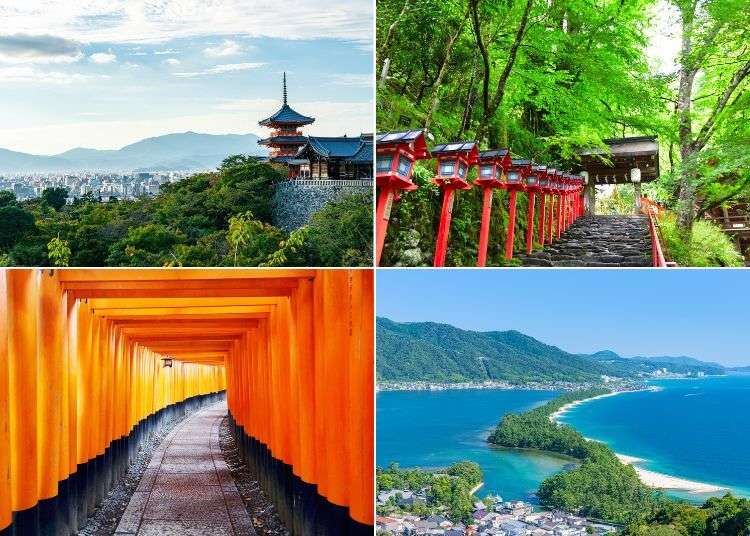
Kyoto Prefecture Guide: Destinations, Activities, Travel Advice, Shopping & More
- Written by: LIVE JAPAN's editorial team
- Translated by: Krys Suzuki
Kyoto Prefecture (京都府) is one of Japan’s most iconic historic destinations, rich in both culture and tradition. It’s home to famous shrines and temples like Kiyomizu-dera, Nijo Castle, and Kinkaku-ji, as well as picturesque neighborhoods like Gion, Arashiyama, and Kibune.
This guide covers everything you need to know before visiting, from seasonal highlights to local cuisine and souvenir picks.
This page contains promotional content.
- Table of Contents
-
- What Makes Kyoto Special?
- Getting to Kyoto via Public Transport
- Spring in Kyoto (March–May)
- Summer in Kyoto (June–August)
- Autumn in Kyoto (September–November)
- Winter in Kyoto (December–February)
- Top Attractions in the Kyoto City Area
- Top Attractions in the Uji and Fushimi Area
- Top Attractions in the Kitayama, Kurama, and Ohara Area
- Top Attractions in the Tango and Maizuru Area
- Must-Try Local Kyoto Dishes
- Kyoto Souvenirs
- The Best Season to Enjoy Kyoto? Whichever You Like Best!
What Makes Kyoto Special?
- Countless historic temples and shrines like Kiyomizu-dera, Nijo Castle, and Fushimi Inari Taisha
- Seasonal landscapes like spring sakura and fall foliage
- Many traditional crafts and cultural activities
- Delicious local delicacies like Kyoto cuisine, obanzai, and matcha sweets
Kyoto served as Japan’s capital for over a thousand years, beginning in the Heian Period (since around 794 AD), and you can still feel the legacy of that long history today. There are countless historic temples, shrines, and traditional streetscapes, making it a favorite destination for both domestic and international travelers.
Kyoto is also famous for its stunning seasonal scenery. There’s cherry blossoms in spring, lush greenery in summer, colorful foliage in fall, and snowy landscapes in winter. And if you head up north, you’ll find Amanohashidate, one of Japan’s three most scenic views.
Kyoto is also known for its traditional craftsmanship and cultural experiences, not to mention its food culture, which includes Kyoto cuisine, obanzai, and matcha sweets.
Sightseeing and Activities
In spring, you’ll want to see the bamboo groves of Arashiyama and the cherry blossoms at Kiyomizu-dera. Summer visitors can enjoy a stroll along the Kamo River or partake in the famous Gion Festival. Autumn brings unforgettable scenes of colorful leaves around Tofuku-ji, Kiyomizu-dera, and Kibune. And if the weather cooperates in winter, you may be lucky enough to see Kinkaku-ji or Ginkaku-ji dusted with snow. Year-round attractions include the thousands of torii gates at Fushimi Inari Shrine, the Kyoto Imperial Palace, and Nijo Castle.
History and Culture
Kyoto is packed with places that immerse you in Japan’s history and culture. Famous landmarks like Kiyomizu-dera, Kinkaku-ji, and Ginkaku-ji are registered UNESCO World Heritage Sites that attract countless visitors from all over, and in traditional districts like Gion and Pontocho, you may even catch a glimpse of a maiko or geiko passing by. Arashiyama is another favorite spot, known for stalls and strolls. You can also try hands-on experiences like traditional crafts or wearing kimono.
Hot Springs and Relaxation
For a relaxing break, head to Arashiyama Onsen! It’s easy to reach from central Kyoto. Or if you prefer a more secluded spot surrounded by nature, make a trip to Yunohana Onsen.
Local Cuisine and Sweets
Kyoto’s culinary scene is as diverse as it is delicious. Kyo-ryori (Kyoto cuisine) is known for delicate flavors that bring out the natural taste of the ingredients, such as tofu, yuba (tofu skins), and seasonal vegetables. Other local favorites include home-style obanzai, hamo (pike conger), and saba sushi (mackerel).
As for sweets, Kyoto also offers an endless array of tasty treats like matcha desserts from Uji, warabi mochi, and yatsuhashi. There’s something for every sweet tooth!
Getting to Kyoto via Public Transport
From Tokyo
To Kyoto City
From Tokyo, take the Tokaido Shinkansen Nozomi train for a direct trip (approx. 2.5 hours). You can also take the Hikari or Kodama trains, but be aware that the ride will be slightly longer. You can book Shinkansen tickets to Kyoto here.
To Uji / Fushimi
From Kyoto Station, take the JR Nara Line to Uji Station (approx. 30 min).
Uji is famous for sites like Byodoin Temple and the Uji River, as well as its culture of matcha. For Fushimi Inari Shrine, take the Keihan Line. It’s just a 5-minute ride from Kyoto Station.
To Arashiyama / Sagano
From Kyoto Station, take the JR Sagano Line to Saga-Arashiyama Station (approx. 20 min). You can also use the Hankyu Line.
This scenic area is home to beautiful nature all year round, with attractions like the Bamboo Groves and Togetsukyo Bridge.
From Osaka
From Osaka, take the JR Kyoto Line (Special Rapid) to reach central Kyoto in about 30 minutes. From there, the Hankyu Kyoto Line, Kintetsu Kyoto Line, and JR Sagano Line will get you to other parts of Kyoto Prefecture.
For specific routes and train schedules, check our convenient LIVE JAPAN Route Search!
There are also various passes that offer great travel deals when using the JR. Be sure to check out the options that best suit your own schedule.
- JR Kansai Mini Pass (3 Days)
- Best for: Budget-conscious travelers on short trips.
At 3,000 yen, this pass offers unlimited JR local and rapid train travel in Kyoto, Osaka, Nara, and Kobe for three days, covering key sites like Fushimi Inari Taisha and Nara Park. It’s ideal for students or backpackers staying 2–3 days, prioritizing affordability and Kansai’s cultural highlights without needing Shinkansen speed.
- JR Kansai WIDE Area Pass (5 Days)
- Best for: Adventurous families or groups exploring beyond Kyoto.
For 12,000 yen, this pass provides five days of unlimited JR travel, including Sanyo Shinkansen, across Kyoto, Osaka, Nara, Okayama, and even up to Tottori. It suits families wanting to mix Kyoto’s temples with kid-friendly spots like Universal Studios Japan or Tottori’s sand dunes, with airport access for convenience. Read more about this pass.
- JR Kansai-Hiroshima Area Pass (5 Days)
- Best for: Culture and history enthusiasts with a regional focus.
Priced at 17,000 yen, this pass covers five days of JR travel in western Japan, including Kyoto, Hiroshima, Nara, and Osaka. It’s perfect for couples or solo travelers keen on Kyoto’s Byodoin Temple and Hiroshima’s Atomic Bomb Dome or even the famous floating torii gate at Miyajima.
- JR Osaka-Tokyo Hokuriku Arch Pass (7 Days)
- Best for: Long-haul travelers combining Kyoto with Tokyo and beyond.
At 30,000 yen, this seven-day pass covers Hokuriku Shinkansen (not Tokaido Shinkansen, so no direct Tokyo-Kyoto Shinkansen) from Osaka to Kyoto, Kanazawa to Nagano, and Tokyo. It’s ideal for first-timers with 7–10 days, seeking a comprehensive Japan experience with airport access (Narita/Kansai). Read more about this pass.
- JR Pass for Whole Japan (7, 14, 21 Days)
- Best for: Extensive explorers visiting multiple regions.
Starting at 50,000 yen for seven days, this pass offers nationwide JR travel, including all Shinkansen lines, covering Kyoto, Tokyo, Hokkaido, and beyond. It suits travelers with 1–3 weeks in Japan, planning to explore far-flung destinations like Sapporo or Fukuoka alongside Kyoto’s cultural sites, maximizing flexibility and speed. Read more about this pass.
Spring in Kyoto (March–May)
Spring in Kyoto is relatively mild, with average temperatures around 8°C (46°F) in March, rising to about 20°C (68°F) by May. You’ll usually be fine during the day with a light jacket or cardigan, but mornings and evenings can get chilly, so it's a good idea to have a light coat or scarf on you just in case.
- Famous Cherry Blossom Spots
- Heian Shrine, Kiyomizu-dera, and Maruyama Park (which is particularly famous for its iconic weeping cherry trees).
- Garden Tours
- Take this time to enjoy beautiful Japanese gardens. Kyoto Gyoen and the Arashiyama Bamboo Grove, home to beautiful flowers and greenery, are also highly recommended.
Summer in Kyoto (June–August)
Kyoto summers tend to get quite hot, with average temperatures reaching around 27–28°C (81–82°F). It’s not uncommon for daytime highs to exceed 30°C (86°F), and the humidity is intense, so heatstroke prevention is key. Wear light clothing and remember to stay hydrated. And if you're looking to escape the summer heat without leaving Kyoto, Kibune is a great choice!
- Gozan no Okuribi
- Held every year on August 16, this summer event features giant bonfires in the shape of written characters on the surrounding mountains.
- Kawadoko Dining
- Enjoy traditional meals under the cool breeze from the riverside platforms <@along the Kamo and Kibune Rivers.
- Gion Matsuri Festival
- The Gion Matsuri is one of Japan’s three major festivals, held in July. Highlights include the Yoiyama event and the grand Yamaboko float procession, which is registered as UNESCO Intangible Cultural Heritage.
Autumn in Kyoto (September–November)
Autumn in Kyoto brings more comfortable weather, with average temperatures around 24°C (75°F) in September. And while the humidity can still make it feel muggy at times, by November, temperatures cool to about 12°C (54°F).
- Fall Foliage Spots
- Kiyomizu-dera, Arashiyama, and Eikando (Zenrin-ji), where colorful leaves paint breathtaking views.
Winter in Kyoto (December–February)
Winters in Kyoto are fairly cold, with average temperatures ranging from 4–7°C. You’ll definitely want to wear a warm coat or down jacket, along with gloves and a scarf. In northern areas like Maizuru, snowfall is common, and since temperatures drop even further at night, it’s important to bundle up. But keep in mind that many indoor places are well-heated, so we recommend wearing layers to make it easier to adjust as needed.
- Illuminations
- At this time, the Sagano Romantic Train transforms into the magical Light Fantasy Train with its stunning light displays. You’ll also find beautiful illuminations all throughout central Kyoto.
Top Attractions in the Kyoto City Area
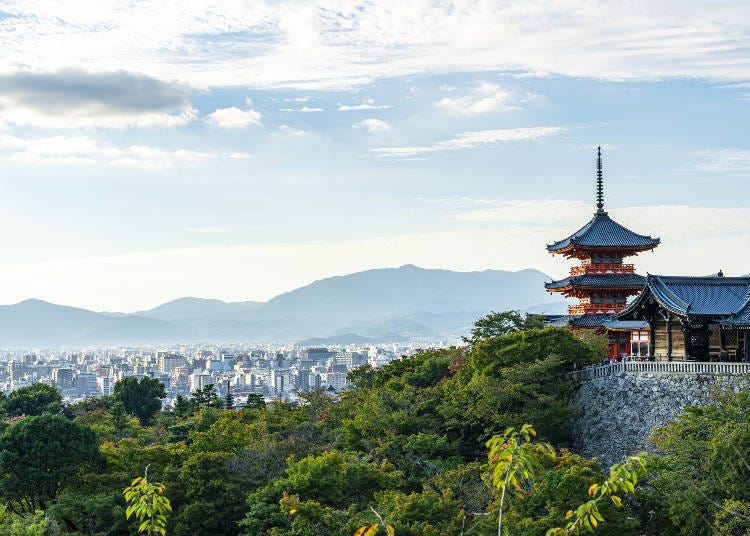
The Kyoto City area is one of the most popular destinations for tourists, packed with historical sites and cultural attractions. Right in the heart of Kyoto, you’ll find must-see sites like Kiyomizu-dera, Kinkaku-ji, and Gion. Other highlights like Arashiyama, Nijo Castle, and the Kyoto Imperial Palace also offer stunning seasonal scenery. We recommend using the buses and subway when exploring this part of the city.
Kiyomizu-dera
Kiyomizu-dera, situated on the slopes of Otowa Mountain, is one of Kyoto’s most iconic temples. The view from its main hall (a designated National Treasure) is breathtaking, especially during spring sakura season and fall foliage season, when large crowds of visitors tend to flock in.
-

-
Address
1-294 Kiyomizu, Higashiyama-ku, Kyoto City, Kyoto Prefecture, 605-0862
View Map -
Nearest Station
Gionshijo Station (Keihan Line)
25 minutes on foot
- Phone Number 075-551-1234
-
Address
1-294 Kiyomizu, Higashiyama-ku, Kyoto City, Kyoto Prefecture, 605-0862
Kinkaku-ji (Rokuon-ji Temple)
Kinkaku-ji (officially named Rokuon-ji), is famous for its three-story pavilion, covered in gold leaf. Its shimmering reflection in the mirror-like pond is one of Kyoto’s most unforgettable sights and an absolute must-see you won’t want to skip!
-

-
Address
1, Kinkakujicho, Kita-ku, Kyoto-shi, Kyoto, 603-8361
View Map -
Nearest Station
Kitanohakubaicho Station (Keifuku Dentetsu-kitano Line)
20 minutes on foot
- Phone Number 075-461-0013
-
Address
1, Kinkakujicho, Kita-ku, Kyoto-shi, Kyoto, 603-8361
Gion
Gion is Kyoto’s most famous geisha district, known for its traditional charm and the sight of maiko and geiko walking the streets. With landmarks like Yasaka Shrine and Hanamikoji Street, it’s the perfect place for a leisurely, atmospheric stroll.
Arashiyama
Arashiyama is a scenic spot known for its natural beauty. The Bamboo Grove and Togetsukyo Bridge are especially famous, with plenty of activities to enjoy like boat rides down the Hozu River and scenic rides on the Sagano Romantic Train.
-

-
Address
Arashiyama Park and others, Ukyo Ward, Kyoto City, Kyoto Prefecture, 616-0000
View Map -
Nearest Station
Arashiyama Station (Keifuku Dentetsu-arashiyama Line)
5 minutes on foot
- Phone Number 075-861-0012
-
Address
Arashiyama Park and others, Ukyo Ward, Kyoto City, Kyoto Prefecture, 616-0000
TOEI Kyoto Studio Park
Step into the world of samurai and ninjas at Toei Kyoto Studio Park, a theme park where you can explore authentic Edo-period film sets and see live jidaigeki (period drama) productions. Visitors can immerse themselves in attractions like the Ninja Mystery House, the 3D Maze Ninja Fort, and the Evangelion Kyoto Base, or transform into a geisha, samurai, or ninja with professional costumes and makeup for a truly cinematic experience.
-

-
Address
Kyoto Prefecture, Kyoto City, Ukyo Ward, Uzumasa Higashihachiokacho 10, 616-8162
View Map -
Nearest Station
Uzumasa Station (JR Sagano Line / JR San-in Line)
5 minutes on foot
- Phone Number 0570-06-4349
-
Address
Kyoto Prefecture, Kyoto City, Ukyo Ward, Uzumasa Higashihachiokacho 10, 616-8162
Nijo Castle
Built by Tokugawa Ieyasu, Nijo Castle is a UNESCO World Heritage Site and has been designated a National Treasure for its historically significant palace buildings. Visitors can tour the lavishly adorned Ninomaru Palace and its expansive gardens.
-

-
Address
541 Nijojocho, Horikawa Nishiiri, Nijo-dori, Nakagyo-ku, Kyoto-shi, Kyoto, 604-8301
View Map -
Nearest Station
Nijojomae Station (Tozai Line)
- Phone Number 075-841-0096
-
Address
541 Nijojocho, Horikawa Nishiiri, Nijo-dori, Nakagyo-ku, Kyoto-shi, Kyoto, 604-8301
Kyoto Imperial Palace
The Kyoto Imperial Palace was once the residence of the emperor, its vast grounds dotted with traditional buildings and beautiful gardens. Open to the public, visitors can even take a tour of the inside.
-

-
Address
3, Kyotogyoen, Kamigyo-ku, Kyoto-shi, Kyoto, 602-0881
View Map -
Nearest Station
Imadegawa Station (Karasuma Line)
8 minutes on foot
- Phone Number 075-211-1215
-
Address
3, Kyotogyoen, Kamigyo-ku, Kyoto-shi, Kyoto, 602-0881
Top Attractions in the Uji and Fushimi Area
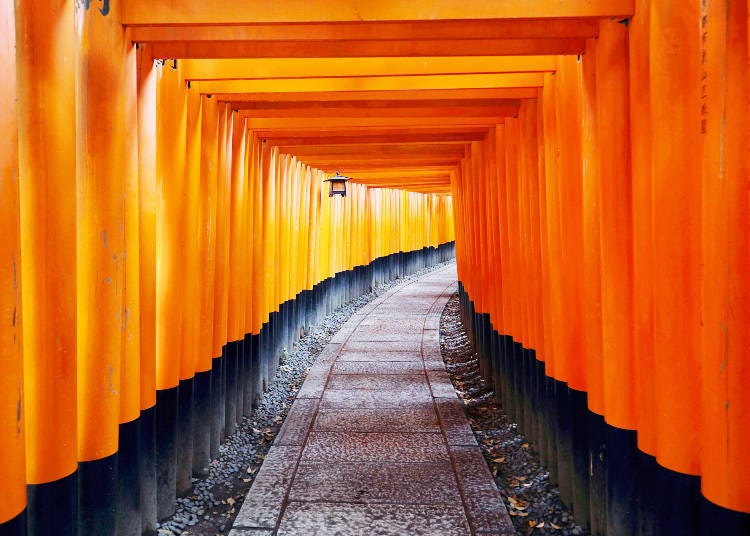
Located in southern Kyoto, the Uji and Fushimi area offers a balance of natural beauty and historical landmarks. Notable attractions include Byodoin Temple, Fushimi Inari Taisha, and the Uji River. There’s also the Nintendo Museum, another visitor favorite! In these areas you can enjoy local specialties like Uji matcha and tour the sake breweries in Fushimi. Areas are easily accessible via the JR Line or Keihan Railway.
Byodoin
Byodoin Temple dates back to the Heian Period and is best known for its Phoenix Hall, pictured on the 10-yen coin. It’s also listed as a UNESCO World Heritage Site.
-

-
Address
116,Ujirenge, Uji-shi, Kyoto, 611-0021
View Map -
Nearest Station
Uji Station (JR Nara Line)
10 minutes on foot
- Phone Number 0774-21-2861
-
Address
116,Ujirenge, Uji-shi, Kyoto, 611-0021
Fushimi Inari Taisha
Fushimi Inari Taisha is the head shrine of over 30,000 Inari shrines across Japan. It's most famous for its thousands of vermilion torii gates, which exude a mysterious, spiritual atmosphere as you walk the paths underneath them.
-

-
Address
68, Fukakusayabunouchicho, Fushimi-ku, Kyoto-shi, Kyoto, 612-0882
View Map -
Nearest Station
Inari Station (JR Nara Line)
- Phone Number 075-641-7331
-
Address
68, Fukakusayabunouchicho, Fushimi-ku, Kyoto-shi, Kyoto, 612-0882
Uji River
The Uji River, which runs through Uji City, is surrounded by beautiful scenery. Tea houses and sightseeing boats line the river, offering a relaxing way to enjoy the area while sipping famous Uji matcha.
Fushimi Sake Breweries
Fushimi has long been a center of sake production, home to many breweries. Several of them offer tours and tastings, making it a great place to experience the appeal of Japanese sake for yourself.
Top Attractions in the Kitayama, Kurama, and Ohara Area
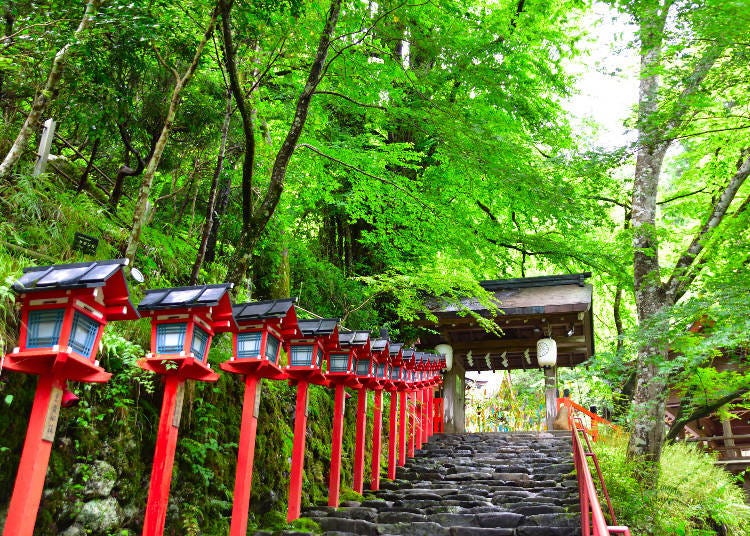
This mountainous area in northern Kyoto is rich in natural beauty and tranquility, home to cultural and spiritual sites like Kurama-dera, Kifune Shrine, and Sanzen-in Temple. With its quiet surroundings, it’s the ideal place to relax and recharge. The area is accessible by the Eizan Railway or by bus.
Kurama-dera
Kurama-dera sits on Mount Kurama and is known for its legends of mythical creatures called Tengu. The approach from the temple gate to the main hall is surrounded by forest, making it a nice, scenic walk.
-

-
Address
1074, Kuramahonmachi, Sakyo-ku, Kyoto-shi, Kyoto, 601-1111
View Map -
Nearest Station
Kurama Station (Eizan Dentetsu-kurama Line)
30 minutes on foot
- Phone Number 075-741-2003
-
Address
1074, Kuramahonmachi, Sakyo-ku, Kyoto-shi, Kyoto, 601-1111
Kifune Shrine
Kifune Shrine is dedicated to a water deity who is also revered as a god of matchmaking. Seasonal attractions include dining on the kawadoko (platforms over the river), and a walk along the beautifully illuminated approach.
-

-
Address
180, Kuramakibunecho, Sakyo-ku, Kyoto-shi, Kyoto, 601-1112
View Map -
Nearest Station
Kibuneguchi Station (Eizan Dentetsu-kurama Line)
30 minutes on foot
- Phone Number 075-741-2016
-
Address
180, Kuramakibunecho, Sakyo-ku, Kyoto-shi, Kyoto, 601-1112
Sanzen-in
Located in Ohara, Sanzen-in Temple is known for its exquisite gardens, steeped in serenity for the perfect, peaceful stroll.
-

-
Address
540, Ohararaikouincho, Sakyo-ku, Kyoto-shi, Kyoto, 601-1242
View Map -
Nearest Station
Kokusaikaikan Station (Karasuma Line)
22 minutes by bus
- Phone Number 075-744-2531
-
Address
540, Ohararaikouincho, Sakyo-ku, Kyoto-shi, Kyoto, 601-1242
Top Attractions in the Tango and Maizuru Area
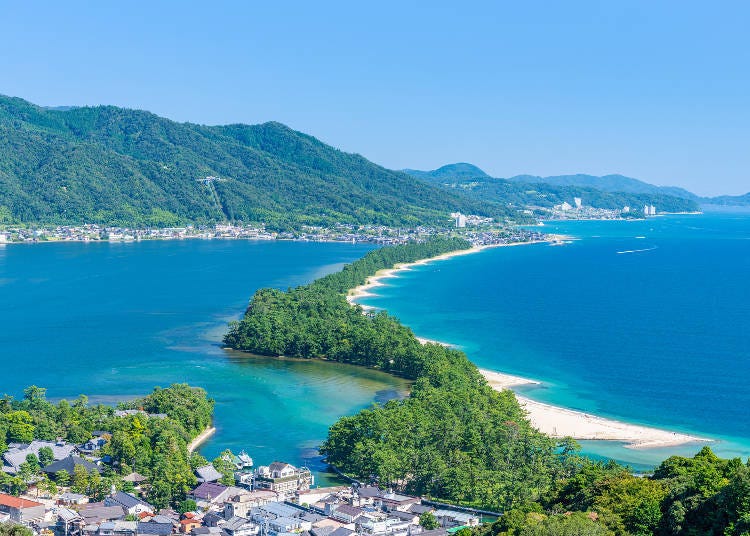
The Tango and Maizuru areas lie along the Sea of Japan in northern Kyoto, and is home to scenic spots like Amanohashidate, Maizuru Bay, and the boathouse-lined coast of Ine. Visitors can enjoy fresh seafood while taking in the natural beauty and historical sites. The area is accessible by the JR Line and by bus.
Amanohashidate
Amanohashidate is one of Japan’s top three scenic spots, known for its natural sandbar that stretches across the bay like a bridge to the heavens. Activities include a ride on a cable car or sightseeing boat.
-

-
Address
Monju, Miyazu-shi, Kyoto, 626-0001
View Map -
Nearest Station
Amanohashidate Station (Tantetsu Miyatoyo Line)
7 minutes on foot
- Phone Number 0772-22-8030
-
Address
Monju, Miyazu-shi, Kyoto, 626-0001
Maizuru Bay
Maizuru Bay offers stunning coastal scenery and port town charm, with notable sites like Maizuru Brick Park and the Japan Maritime Self-Defense Force Memorial Hall.
Ine
Tucked along the scenic coast of northern Kyoto, Ine is a picturesque fishing village known for its unique “funaya” boat houses that sit right on the water. With its tranquil bay views and timeless charm, it’s a perfect escape for travelers seeking a quiet slice of traditional Japan.
Must-Try Local Kyoto Dishes
Yudofu
Yudofu is one of Kyoto’s signature dishes. In fact, you’ll find lots of well-known restaurants specializing in this hot tofu dish right around Nanzen-ji Temple. Simmered in kelp-based broth, this delicious tofu is silky and melt-in-your-mouth soft.
Kyo-kaiseki Cuisine
Kyo-kaiseki is a traditional multi-course cuisine from Kyoto. It features beautifully plated seasonal ingredients in elegant dishware, offering a refined dining experience for both the eyes and the palate.
Matcha Sweets
Kyoto is famous for matcha sweets, often made with high-quality Uji matcha and loved for their rich flavor and refined sweetness. The matcha parfaits and ice cream from Tsujirihei Honten and Nakamura Tokichi Honten are especially popular with locals and tourists alike.
Nishin Soba
Nishin soba is a traditional Kyoto soba dish featuring buckwheat noodles, and topped with sweet and savory simmered nishin (herring). It’s known for its rich, flavorful broth, making it an especially comforting dish during the colder months.
Obanzai
Obanzai is a style of home cooking from Kyoto, known for its simple yet nourishing dishes of seasonal vegetables and tofu. Served in an assortment of colorful small bowls, obanzai is appreciated as a healthy, well-balanced meal.
-
 Dining in Kyoto: Best Restaurants for Kaiseki, Sushi, Cafes & More
Dining in Kyoto: Best Restaurants for Kaiseki, Sushi, Cafes & More
Read more ▶ -
 Dining in Gion (Kyoto): 40 Best Restaurants for Kaiseki, Sushi, and Matcha Desserts
Dining in Gion (Kyoto): 40 Best Restaurants for Kaiseki, Sushi, and Matcha Desserts
Read more ▶ -
 1-Day Kyoto Foodie Itinerary: A Guide to Sampling the Best of Kyoto's Cuisine
1-Day Kyoto Foodie Itinerary: A Guide to Sampling the Best of Kyoto's Cuisine
Read more ▶ -
 15 Must-Try Restaurants Near Kyoto Station: From Yakiniku to Ramen, Kaiseki, Matcha, and More
15 Must-Try Restaurants Near Kyoto Station: From Yakiniku to Ramen, Kaiseki, Matcha, and More
Read more ▶
Kyoto Souvenirs
Yatsuhashi
Yatsuhashi is one of Kyoto’s most iconic traditional sweets. Varieties include nama-yatsuhashi, made with cinnamon-flavored dough wrapped around sweet red bean paste, and yaki-yatsuhashi, which are baked to a crunchy texture. The soft, chewy nama-yatsuhashi is especially known for its delicate sweetness, making it a favorite Kyoto souvenir.
Kyo Baum
Kyo Baum is a Kyoto-style baumkuchen cake made with layers of matcha and soy milk. It has a moist texture and rich flavor, offering a modern twist on Kyoto tradition. Its stylish packaging also makes it a great gift!
Chirimen Sansho
Chirimen sansho is a preserved, Kyoto-style simmered dish made with tiny dried fish (chirimen jako) and Japanese peppercorns (sansho). It goes great with rice and has a uniquely Kyoto flavor. And with a rather long shelf life, it also makes a great souvenir!
Kyoto Tsukemono
Kyoto tsukemono (pickled foods) are made with traditional methods passed down for generations, with different varieties available throughout the year. Popular ones include senmaizuke, shibazuke, and sugukizuke, each with their own distinct Kyoto taste. They're also a great gift for your health-conscious friends and family!
Kiyomizu Wares
Kiyomizu wares are a traditional form of Kyoto pottery, known for its delicate craftsmanship and hand-painted designs. Teacups, bowls, and vases are not only practical but also make thoughtful gifts that reflect Kyoto’s history and artistry, with every piece holding the warmth of handmade tradition.
The Best Season to Enjoy Kyoto? Whichever You Like Best!
Kyoto is home to an abundance of attractions, no matter the season! So if you're planning your trip, all you need to do is check which events and seasonal activities are happening during your visit, and have fun!
(Information in article as of April 2025. Please see official sites for the latest updates and information.)
LIVE JAPAN's editorial team is a multicultural mix of native editors who have lived in Japan for over five years, alongside Japanese editors with a deep passion for travel. We're devoted to sharing the wonders of Japan. From cultural insights and history to events, practical travel tips and coupons, we're here to help make your journey unforgettable!
Krys is a 2023 MEXT Research Scholar currently residing in Kyoto, Japan. She graduated Magna Cum Laude with a BA in Japanese Translation and Interpretation via the CUNY Baccalaureate Program from Hunter College in New York City. After working as an ALT with the JET Program from 2013-2015, she transitioned to freelance writing and translation in 2016. Since then, Krys has cumulatively translated and/or written about over 200 cities, towns, shrines, shops, and restaurants in various parts of Japan. She also has experience translating articles, manga, and light novels.
- Area
- Category
*Prices and options mentioned are subject to change.
*Unless stated otherwise, all prices include tax.
Recommended places for you
-
Events

Sunflower terminal (Osaka) Terminal 1
Other Sightseeing
USJ, Nanko Port
-

ISHIDAYA Hanare
Yakiniku
Kobe, Sannomiya, Kitano
-

Kanzenkoshitsuyakinikutabehodai Gyugyu Paradise Sannomiya
Yakiniku
Kobe, Sannomiya, Kitano
-

Jukuseiniku-to Namamottsuarera Nikubaru Italian Nikutaria Sannomiya
Izakaya
Kobe, Sannomiya, Kitano
-
Goods
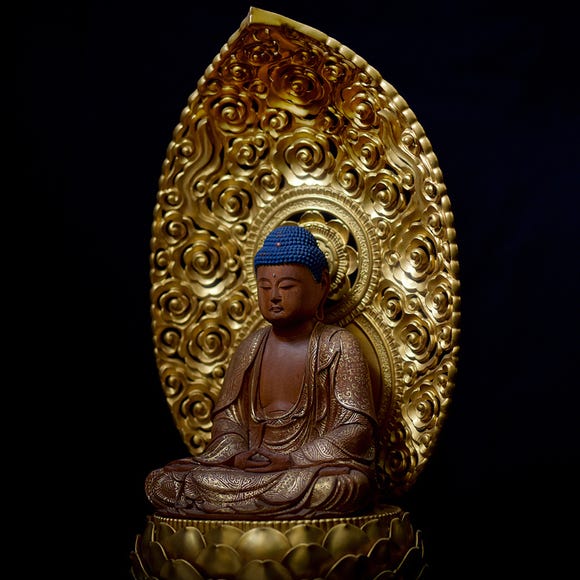
Yoshida Gennojo-Roho Kyoto Buddhist Altars
Gift Shops
Nijo Castle, Kyoto Imperial Palace
-
Events

Osaka JOINER
Other Sightseeing
Namba, Dotonbori, Shinsaibashi
-

What to Eat and Buy at Expo 2025 Osaka–Kansai: Special Menus and MyakuMyaku Crafts
by: Kaori Kimura
-

teamLab Announces New Permanent Kyoto Museum Opening in Fall 2025
-

Hotel Universal Port: A Fun-Filled Stay Where You Can Meet the Minions (In-Depth Review)
by: Tabiningen
-

Experiences Inside The Osaka-Kansai Expo 2025: Sushi-Making, 3-Meter-Tall Mega Cranes, and More!
by: Kaori Kimura
-

2025 Osaka-Kansai Expo: Convenient Tips for a Stress-Free Visit
by: Kaori Kimura
-

Experience Hotel New Otani Osaka: Overnight Journey of Japanese Culture and Fine Dining (2-Day Itinerary)
by: Yotsuka Hizuki
Inspiration for Accommodations
-

Spacious Family Hotel in Namba: 20 Comfortable Stays for Family Fun
-
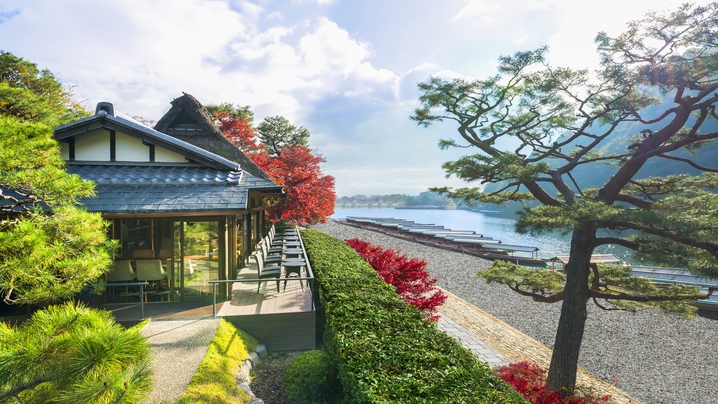
Charming Hotels to Enjoy the Spectacular Views of Arashiyama's Autumn Leaves from Your Room
-

Experience Stunning Views of Osaka Castle from Private Spaces: Top Hotels Near Osaka Castle
-
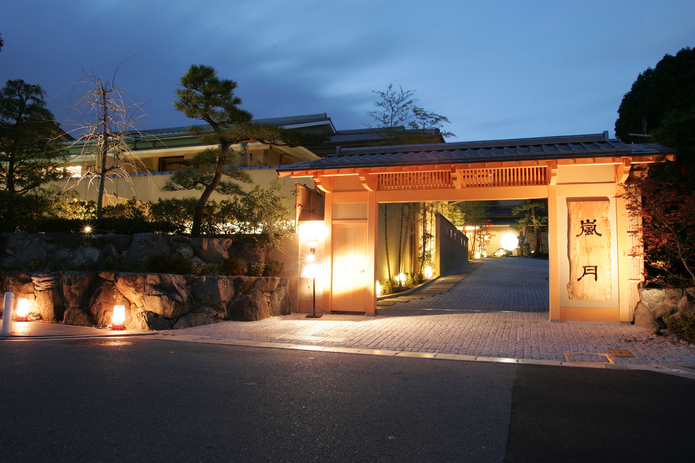
Recommended by Visitors! Arashiyama's Best-Rated Hotels
-

Family-Friendly Universal Studios Japan Hotel with Excellent Access
-
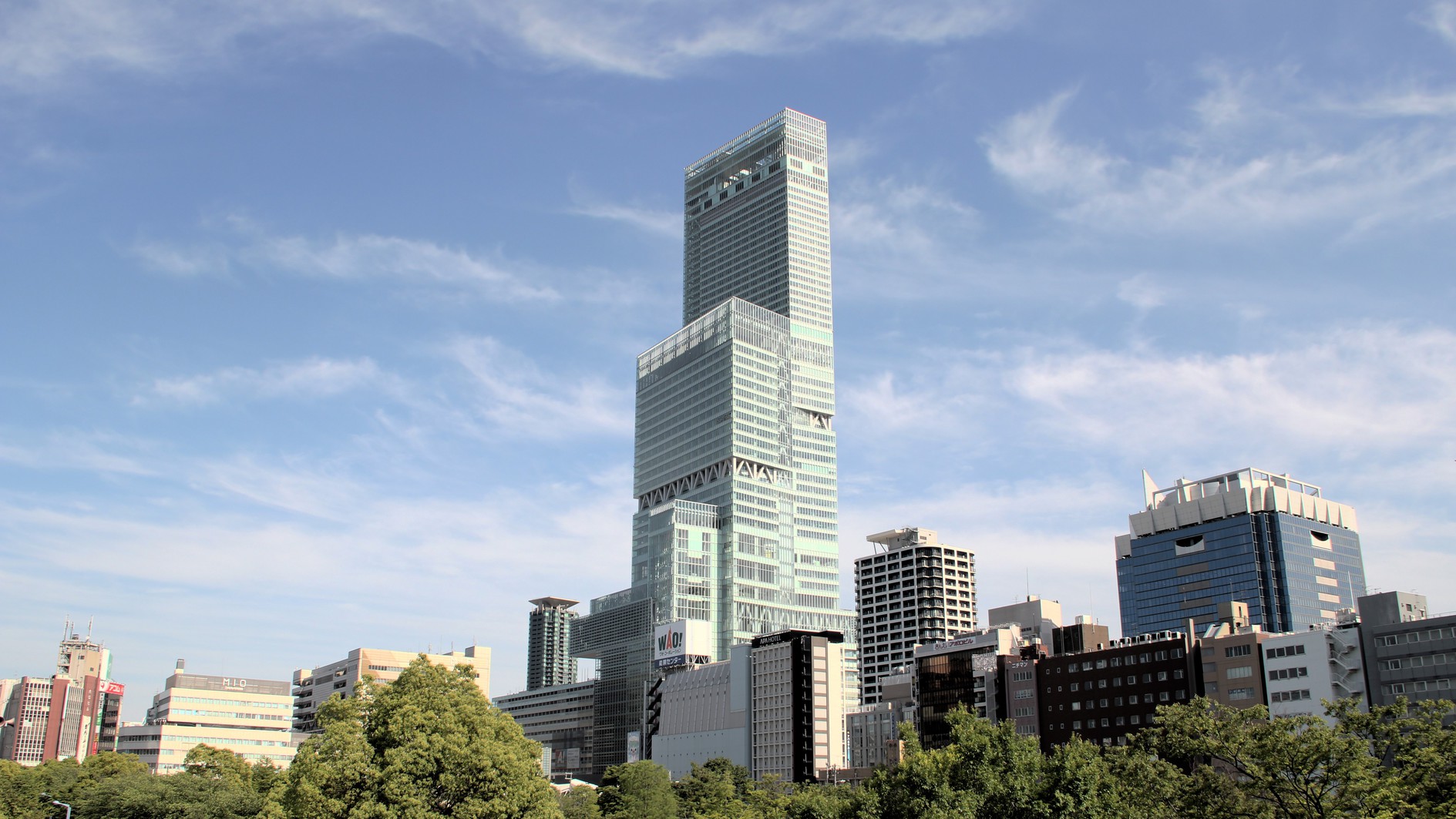
Enjoy a Comfortable Stay in Osaka! 10 Hotels with Convenient Airport Shuttle Services
-

Top 10 Recommended Hotels Near Namba Station with Great Access
-

Enjoy Night Views from Your Room! Recommended Hotels in Namba Area
-

Kichijoji – Explore Tokyo’s Top-Rated Stylish Suburb in Half a Day!
-

32 Epic Things to Do in Osaka: From Historic Tours to Go-Karting, Traditional Performances, and Festival Extravaganzas
-

Osaka Koreatown: In Search of the Best Eats in the Korean Roots of Osaka's Tsuruhashi Market
-

38 Best Things to Do in Kyoto: See, Eat, and Shop Your Way Through Japan's Cultural Capital
-

Kansai Sightseeing Passes: See Western Japan on a Budget With These 5 Travel Deals!
-

5 Must-See Kansai Area Attractions - Recommended By 167 Foreign Visitors!
by: WESTPLAN
- #best gourmet Osaka
- #things to do Osaka
- #what to do in kyoto
- #what to bring to japan
- #best gourmet Kyoto
- #new years in Osaka
- #what to buy in nanba
- #Visiting Osaka
- #onsen tattoo friendly arima
- #daiso
- #Visiting Kyoto
- #best japanese soft drinks
- #japanese fashion culture
- #japanese convenience store snacks
- #japanese nail trends








































